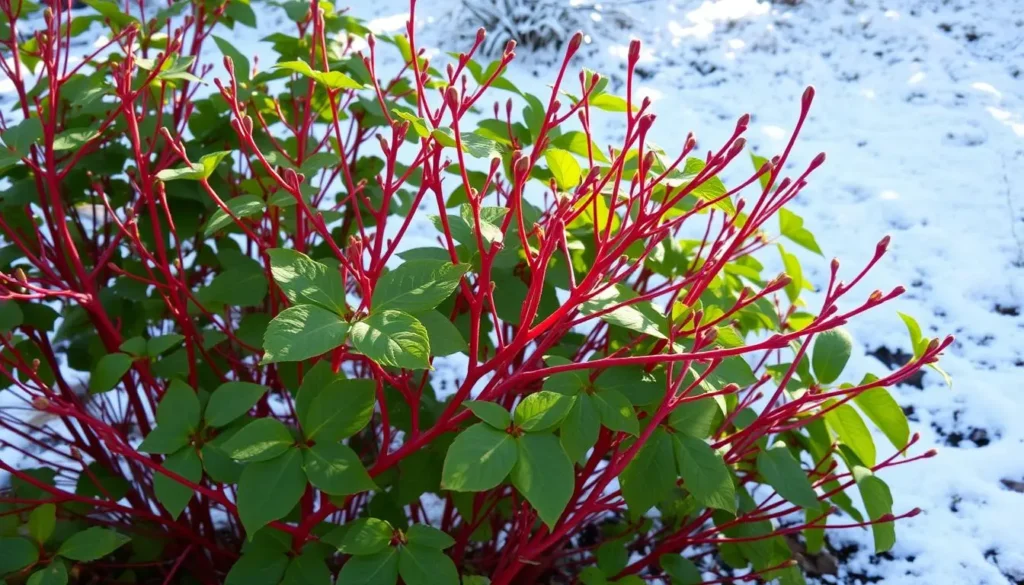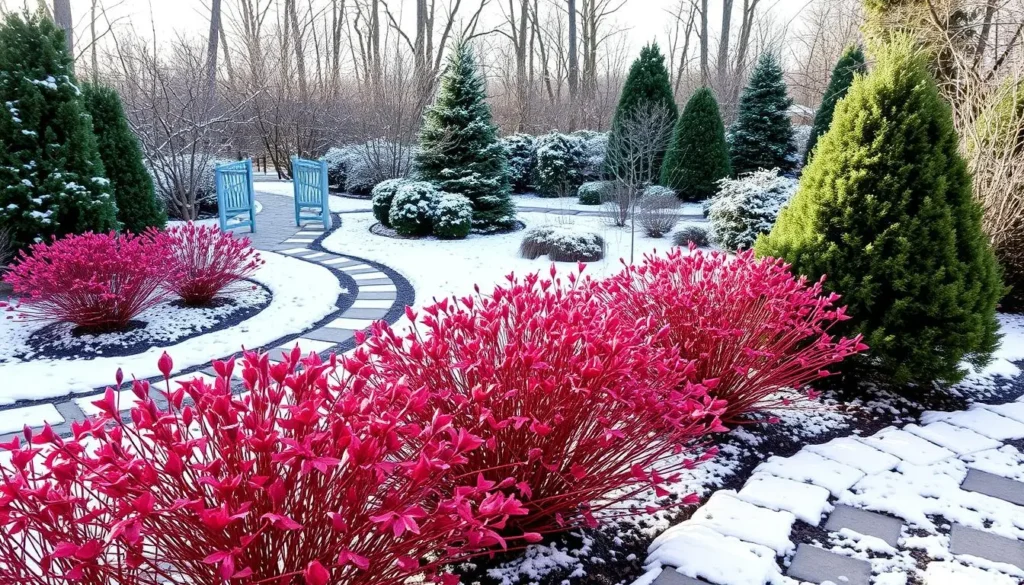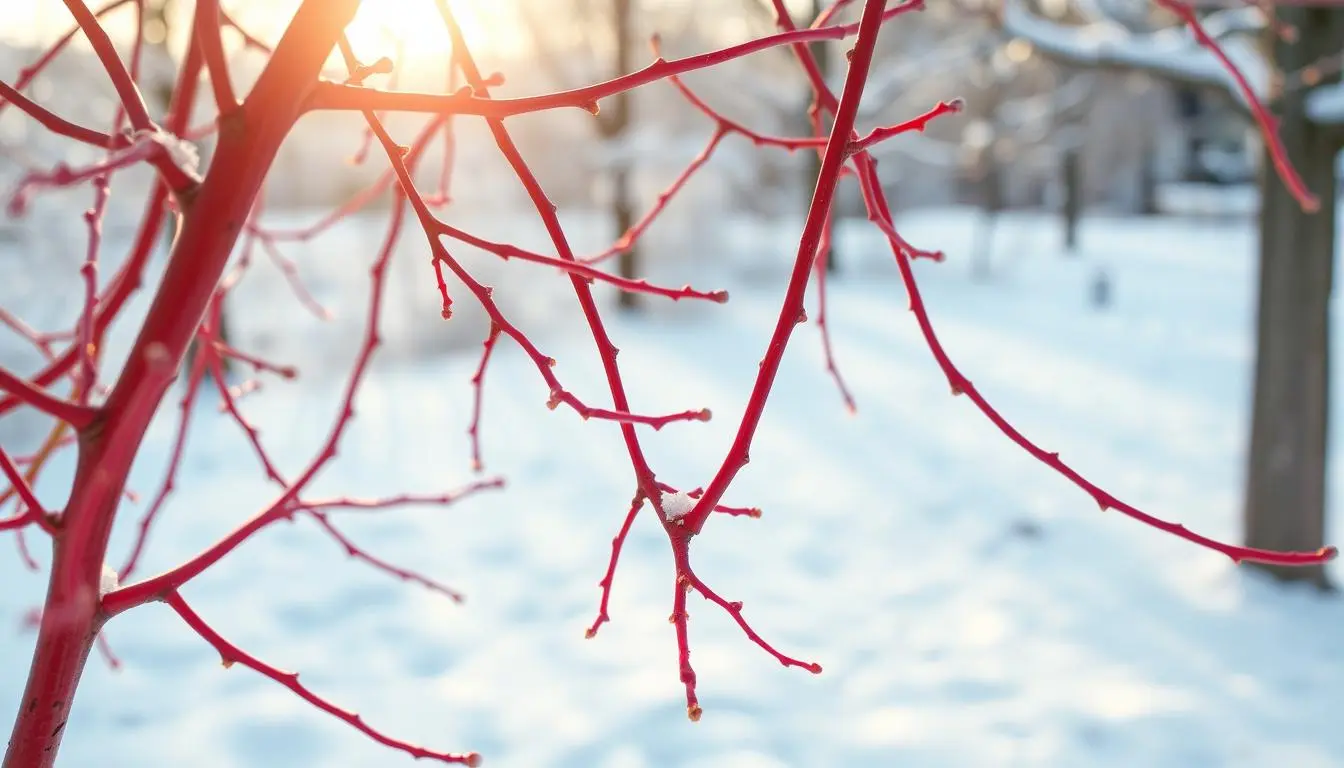Winter can make our gardens look dull. But the Red Twig Dogwood changes that. This shrub turns your garden into a colorful winter wonderland. Its bright red stems and white spring blooms stand out against the cold.
If you love gardening, you’ll adore the Red Twig Dogwood. It’s easy to care for and grows well in many places. Let’s explore how it can brighten up your winter garden.
Table of Contents
Understanding Red Twig Dogwood: An Introduction
Red twig dogwood shrubs, also known as Cornus sericea or Cornus stolonifera, are a vibrant addition to gardens. They are native to North America and thrive in many parts of the United States and Canada. Knowing about their origins, characteristics, and varieties helps you choose the right shrubs for your garden.
Native Origins and Natural Habitat
The red twig dogwood grows naturally in moist, well-drained soils. You can find them along riverbanks, stream beds, and wetlands. They are common in the eastern and central parts of North America, adding color to landscapes even in winter.
Basic Characteristics and Growth Habits
These shrubs are known for their bright red or purple stems. They can grow 6 to 10 feet tall and spread 8 to 12 feet wide. Their green leaves turn reddish-purple in fall, enhancing their beauty.
Common Varieties and Cultivars
There are many varieties of red twig dogwood, but the Arctic Fire Red Twig Dogwood stands out. It has a compact shape and intense red stems. Other varieties like Baileyi and Flaviramea have yellow or orange-red stems, offering more color options.
“The vibrant color of red twig dogwood shrubs adds a stunning visual contrast to any winter landscape.”
Why Red Twig Dogwood Stands Out in Winter Landscapes
When winter hits, the red twig dogwood becomes a garden superstar. Its bright red stems stand out against the snow, bringing color and life to quiet gardens. This shrub is essential for any winter garden.
The red twig dogwood is special because it adds structure and focus to the garden. When other plants sleep, its red stems wake up the garden. They draw the eye and make the landscape feel deeper and more interesting. You can use it to frame garden beds, line paths, or make striking hedges.
Also, the red twig dogwood is easy to care for and grows well in many places. This makes it perfect for winter gardens. It fits into both formal and natural garden styles.
“The bright red stems of the red twig dogwood provide a stunning contrast against the snow, adding a pop of color that can’t be matched by any other plant in the winter landscape.”
If you want to make your garden more interesting in winter, get the red twig dogwood. Its bold color and flexibility make it a top pick for any red twig dogwood landscape design. Your garden will sparkle, even when it’s cold.
Growing Requirements for Healthy Red Twig Dogwoods
To make sure your red twig dogwood shrub grows well, knowing the best growing conditions is key. These plants love soil that drains well and is slightly acidic, with a pH of 5.5 to 6.5. They do best in full sun to partial shade, needing at least 6 hours of direct sunlight daily.
Soil Conditions and pH Preferences
Red twig dogwoods can grow in many soils but do best in moist, well-draining soil with lots of organic matter. Don’t plant them in heavy clay soils, as this can cause root rot. Adding compost or aged bark to the soil can help it drain better.
Sunlight and Water Needs
- Sunlight: These shrubs need full sun to partial shade, with at least 6 hours of direct sunlight daily for the best growth and color.
- Water: Keeping the soil moist but not too wet is important for red twig dogwoods. Water them often, adjusting how much based on weather.
Temperature and Climate Considerations
Red twig dogwoods are hardy and can handle many climates, from USDA Hardiness Zones 3 to 8. But, they might struggle in very hot, dry summers or harsh winters. Mulching around the plant helps keep the roots cool and moist during hot, dry times.
By knowing the specific growing needs of red twig dogwoods, you can create the perfect environment for them to flourish in your garden all year round.
Planting and Establishing Your Red Twig Dogwood Shrubs
Planting a red twig dogwood bush in your garden can be very rewarding. To make sure it grows well, follow the right steps. First, pick a spot that’s right – red twig dogwoods like well-drained, slightly acidic soil and partial shade to full sun.
Before planting, loosen the soil to 12-15 inches deep. Mix in compost or peat moss to make the soil perfect for your shrub. When you plant, dig a hole that’s twice as wide and deep as the root ball. Carefully put the shrub in the hole and fill it with the mixed soil.
- Water the new red twig dogwood well, making sure the soil is moist but not too wet.
- Put a 2-3 inch layer of mulch around the plant, but don’t pile it against the stem.
- Stake the shrub if needed to help it grow straight and prevent wind damage.
It takes time and patience for a red twig dogwood bush to grow strong. Keep watering it, especially in the first year, to help its roots grow. Don’t prune too much or disturb the roots during this important time.

With the right care and planting, your red twig dogwood shrub will grow beautifully. It will add stunning winter color to your garden for many years.
Essential Maintenance and Pruning Techniques
To keep your red twig dogwood shrubs healthy and looking great, you need a good pruning plan. Stick to a seasonal schedule and use the right tools and methods. This way, your plants will stay vibrant and show off their beautiful winter stems.
Seasonal Pruning Schedule
The best time to prune your red twig dogwood is in late winter or early spring. Prune before new growth starts. This lets you shape the shrub and remove dead or damaged branches without harming the next season’s growth.
Tools and Methods
When you prune, use sharp, clean shears or loppers. This prevents pests and diseases. Cut just above an outward-facing bud or lateral branch. This helps the shrub grow in the right direction.
Rejuvenation Pruning Tips
If your red twig dogwood is too big or has lost its color, rejuvenation pruning can help. Every 3-4 years, cut the shrub back to 6-12 inches from the ground. This drastic cut will encourage new, colorful stems to grow.
By using these pruning and maintenance tips, your red twig dogwood will keep looking amazing for years. It will continue to add winter color to your garden.
Landscape Design Ideas with Red Twig Dogwood
Red twig dogwood offers endless design options for your garden. It can be a focal point, a mass planting, or part of a mixed border. Let’s look at some creative ways to use red twig dogwood in your garden.
Using red twig dogwood as an accent plant is popular. Place one near a path or at a garden bed’s edge. It adds color in winter with its bright red stems. This makes a striking focal point that will impress your guests.
Planting red twig dogwood in groups is another great idea. It makes a living hedge or screen, offering privacy and interest all year. The shrubs together create a colorful tapestry that enhances your garden ideas.
Adding red twig dogwood to a mixed border is also smart. Mix it with plants that offer different textures and bloom times. Pair it with perennials, grasses, and small trees for a dynamic garden.

“The brilliant red stems of the red twig dogwood provide a striking contrast against the winter landscape, adding a vibrant and unexpected element to any garden.”
Exploring red twig dogwood design options can make your garden more interesting. Whether as a focal point, mass planting, or mixed border feature, it will stand out in your garden ideas.
Common Pests and Diseases: Prevention and Treatment
Red twig dogwood adds beauty to any garden. But, it needs careful care to stay healthy. Knowing about common pests and diseases helps keep these shrubs strong. Early detection and prevention strategies ensure your red twig dogwood stays vibrant for years.
Identifying Common Issues
Aphids, scale insects, and leaf-feeding beetles are common pests. They can make leaves turn color, stunt growth, and even kill the plant if not treated. Diseases like powdery mildew, cankers, and root rot also harm your plants.
Natural and Chemical Solutions
Dealing with red twig dogwood pests requires a mix of methods. Start with natural solutions like introducing ladybugs or lacewings to fight aphids. For tougher problems, use organic pesticides or fungicides.
Preventative Measures
- Keep soil pH and nutrients right for strong growth
- Water right, avoiding too much to prevent root rot and disease prevention
- Prune sick parts quickly to stop disease spread
- Check plants often for pest or disease signs
Being watchful and taking action early keeps your red twig dogwood healthy. Enjoy its bright colors all winter long.
Companion Plants and Garden Combinations
Creating a stunning garden is all about the right plants. Red twig dogwoods add vibrant color in winter. They look great with plants that highlight their beauty. Discover how to make your garden more appealing with companion planting.
Pairing red twig dogwoods with lush perennials is a great idea. Try adding Echinacea (coneflowers) or Rudbeckia (black-eyed Susans) around them. These flowers offer a bold contrast to the dogwood’s striking stems.
For a calm look, mix red twig dogwoods with Carex (sedges) or Hakonechloa (Japanese forest grass). Their soft leaves frame the dogwood’s winter beauty.
- Combine red twig dogwoods with Hydrangea for a stunning color contrast in all seasons.
- Underplant red twig dogwoods with Helleborus (Lenten roses) for a charming wintertime display.
- Introduce Buxus (boxwood) as a low-growing, evergreen companion to enhance the red twig dogwood’s winter interest.
Choosing the right plants can make your garden pop. With the right companions, your red twig dogwoods will shine all year round.
Creating a Red Twig Dogwood Hedge for Privacy
Looking for a vibrant addition to your landscape? Consider a red twig dogwood hedge for privacy. These shrubs are not just beautiful but also act as a strong privacy screen. With a few simple steps, you can grow a stunning red twig dogwood hedge. It will make your outdoor space more beautiful and private.
Spacing and Layout Guidelines
Start by planning the spacing and layout of your red twig dogwood hedge. These shrubs grow 6 to 10 feet tall and 6 to 12 feet wide. So, give each plant enough space. Space them 3 to 5 feet apart for a dense hedge.
Maintenance Requirements
To keep your red twig dogwood hedge healthy, regular care is needed. Prune them in late winter or early spring to promote new growth. Also, water them well, especially when it’s dry, to help them thrive.
Design Considerations
Think about how your red twig dogwood hedge will fit into your landscape design. These shrubs can stand alone as a privacy screen or be part of a bigger garden. Try different patterns, like staggered rows or curves, to make your hedge interesting and useful.
By following these tips, you can make a beautiful and useful red twig dogwood hedge. It will add privacy and beauty to your outdoor space for many years. Enjoy the vibrant colors and versatility of this amazing shrub to turn your landscape into a peaceful oasis.
Conclusion
The Red Twig Dogwood is a standout shrub for your winter garden. Its bright red stems add color and interest to your landscape. It’s perfect as a focal point, privacy hedge, or with other winter plants.
This shrub is also easy to care for. With the right conditions and pruning, it will thrive for years. Consider it for your next landscape project to enhance your red twig dogwood, winter garden, and landscape design.
The Red Twig Dogwood is essential for a beautiful winter garden. Its vibrant colors and versatility make it a top choice for gardeners. Let it be the highlight of your winter garden showcase.

